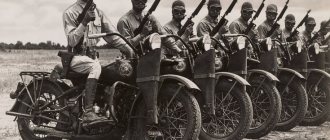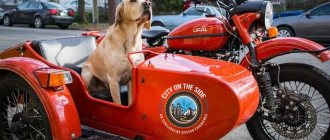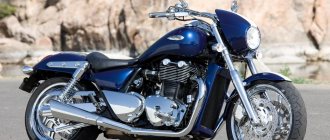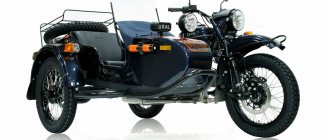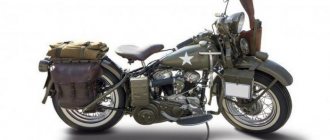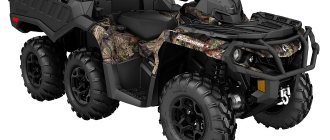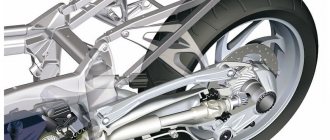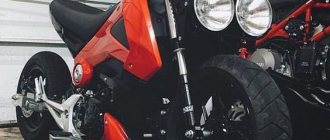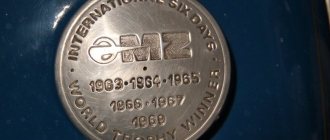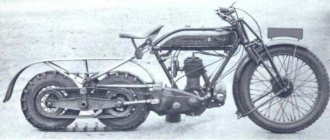If we are honest and objective, then perhaps the most correct conclusion will be that the history of the domestic motorcycle industry really begins with the Second World War. While neighboring countries were testing developments in the production of motorcycles, our country was solving its internal problems, which, against the backdrop of the First World War and the change of government and political system, did not find a place for a motorcycle project. Although later, when reading Soviet textbooks on motorcycle construction, you find interesting references created by censorship, you will not see anywhere that the most famous motorcycle was constructed from the developments of the enemy and the allies. Soviet textbooks prefer to remain silent about prototypes of their own developments.
Benelli 250 TN - motorcycles of the war years
These are Italian two-wheelers that were mass-produced, starting back in 1936, not only military motorcycles, but also civilian ones. This same iron horse was actively used in World War II. With a 246.79 cc engine. working volume, this vehicle entered service with the army due to its fuel efficiency and practical reliability. Its double tubular steel frame copes well with all kinds of combat loads.
A single-cylinder four-stroke engine equipped with a 3-speed gearbox allowed certain branches of the military to be more mobile. The Benelli 250 TN combat motorcycle was equipped with drum brakes and a manual gear shift mechanism. The latter was located in close proximity to the gas tank.
Other original models
The original model of a military motorcycle was developed in Italy. Guzzi presented a tricycle with a machine gun and an armored shield. A feature of this modification was the “dead” placement of the machine gun, directed backwards.
Belgian designers also tried to create something unique in this regard. In 1935, FN presented a simplified model of the M-86. Compared to other European analogues of that time, the car received a number of advantages:
- Forced engine with a volume of 600 cc.
- Reinforced frame.
- Armored front and side sheets.
- Possibility of transporting an armored stroller with a Browning machine gun.
During serial production, over 100 similar copies were produced, operated by the armies of Romania, Brazil, China and Venezuela.
Czechoslovakian military motorcycles CZ 500 Tourist
Czechoslovakian wartime motorcycle. This motorcycle first rolled off the assembly line back in 1938. It was produced until the beginning of the Great Patriotic War (until 1941) on . In addition to military needs, this bike also served the civilian population. In total, they managed to produce a little less than 600 of these two-wheelers. Interestingly, a more expensive version of this iron horse was produced specifically for use in the Pope's guard. I would like to note that this combat motorcycle is painted black, which goes well with the chrome parts of the bike. Yet for the purposes of warfare this is not at all important.
German military motorcycle DKW RT 125
German wartime motorcycleThe iron war horse “DKW RT-125” is considered perhaps the most cloned motorcycle in the history of mankind. He was feasted everywhere. This is not surprising, given that the two-wheeler had a very reliable two-stroke engine made in Germany. It was mass produced starting in 1939 and ending back in 1965. made from this line of steel horses a truly national German model of mechanical two-wheeled transport.
The appearance of this combat motorcycle from Germany was designed by Hermann Weber. He gave the most romantic type of transport even greater grace. The bike was equipped with a very powerful, at that time 123 cc engine capable of producing 6.5 horses. This iron horse had at its disposal a reliable electronics system, including a battery (battery). Gasoline was supplied mixed with engine oil directly into the tank. Fuel consumption was approximately two and a half liters per 100 kilometers traveled.
Features of "Ural"
The high dynamics of the military motorcycle, the photo of which is shown above, cross-country ability and maneuverability are ensured by a powerful engine, transmission and chassis. The bike has a base shortened to 1.5 meters, large 19-inch wheels with an all-terrain tread pattern.
The design and layout of the working elements is made according to the automotive principle:
- Motor lubrication system.
- The checkpoint is in a separate block.
- Cardan transmission shaft.
These features guarantee a high level of reliability and maintainability. The working life is increased by observing the use of suitable automotive-type motor and transmission oils.
The Ural combat motorcycle with a trailer has a particularly important parameter for performing combat missions - the ability to overcome obstacles that are beyond the capabilities of most vehicles. With the wheelchair raised, the equipment can move along one track while maintaining balance. This allows you to bypass deep holes and obstacles up to 70 centimeters high. The weight of the motorcycle is 315 kilograms, which makes it possible for the crew to turn the unit over a fallen tree or barrier structure. Speeds of up to 100 km/h provide a high margin of time for maneuvering, while operation of the bike in question is possible in various climatic zones (from – 40 to + 50 degrees).
Grokhovsky's combat motorcycle
Military motorcycle of GrokhovskyMilitary motorcycles of the USSR sometimes had a fantastic appearance, reminiscent of the appearance of a tank or some kind of armored personnel carrier. Thus, the Soviet armored motorcycles (armored motorcycles) of Grokhovsky were based on a half-track and could accommodate only one warrior, completely protected from all sides by sheets of armor. This transport was developed even before the start of the Great Patriotic War. Work on its creation began at the very beginning of the 30s. last century. Then aircraft designer Pavel Grokhovsky was impressed by Western ultra-light armored vehicles equipped with a massive machine gun. Nevertheless, the communist leadership of the country was not at all interested in what this Soviet inventor created. The bike remained an unrealized concept. But German military motorcycles on half-tracks learned a lot from such a mobile idea (though without armor).
Post-war revitalization
In 1928, the French military motorcycle Mercier was presented. The front track wheel added originality to this creation. After 10 years, engineer Leêtre created a modernized analogue of this machine, called Tractorcycle, fully equipped with caterpillar tracks.
It was assumed that excellent maneuverability and light armor should provide the model with recognition and success in the military sphere. However, the bike had a number of significant disadvantages:
- Large mass (over 400 kg).
- Low speed setting (up to 30 km/h).
- Poor handling.
- Unstable roads.
Despite the fact that the designers soon added side wheels to the design, the army was never interested in this development.
Soviet military motorcycle TIZ AM-600
Soviet wartime motorcycle TIZ AM 600 This two-wheeled iron horse began to be mass produced at the Taganrog Tool Plant long before the start of the Second World War. With the beginning of the war in 1941, the military leadership of the USSR decided to abandon the production of such equipment. Nevertheless, this motorcycle can be considered a motorcycle of the war years, since its assembly line production took place after the transfer of production to Tyumen. The combat bike was produced until 1943.
The use of this transport in the Red Army was widespread. Still, few of the officers knew that when operating the TIZ AM 600, he was riding a double of the famous English motorcycle BSA Sloper. Interestingly, in addition to military operations, such motorcycles were used in holiday parades. During the entire period of their operation, compatriots left only positive reviews regarding the reliability and durability of two-wheeled vehicles.
Harley-Davidson
Also popular in recent years is the Harley Davidson army motorcycle with a 350cc two-stroke single-cylinder Rotax engine. This modification is common in various countries of the world and is used as a vehicle for reconnaissance or escort. Among the disadvantages of this model is the use of J-8 fuel, which in composition is more reminiscent of a mixture of diesel fuel and aviation kerosene. This makes it unsuitable for use on gasoline engines. There are exceptions, such as the HDT M103M1 model. The average speed of the device is 55 miles per hour.
Military motorcycles of the USSR - PMZ A 750
Soviet military motorcycles PMZ A 750 The three-wheeled combat motorcycle PMZ-A-750 is considered the first domestic heavy bike. Its first samples were rolled off the assembly line back in 1934. The iron horse was mass produced until the beginning of World War II. Only in 1939, the Podolsk Mechanical Plant stopped producing this type of transport, having managed to give its compatriots more than 4,500 thousand beautiful heavy motorcycles.
PMZ produced not only three-wheeled bikes. Quite a few models without a side trailer (sidecar) came off the assembly line. First of all, this combat motorcycle was supplied to the Red Army. Yet in civil services its use was not exclusive. This iron horse even made it into Soviet cinema (the film Tractor Drivers).
World War II period
The first and only ones of their kind were two German military motorcycles with a sidecar: the BMW R75 and the Zundapp KS750. They were specially designed with off-road travel in mind. Wheel drives and special speeds equipped specifically for this purpose allowed these machines to be recommended exclusively on the positive side.
Due to the high price, the models in question were first supplied to parachute units and the Afrika Korps, and later to the SS troops. In 1942, a decision was made to produce an improved Zundapp KS-750 with a BMW 286/1 sidecar (a military motorcycle stored in a strategic reserve). It never went into production. Production was planned for the period after the order for 40 thousand copies of the R-75 and KS-750 was completed, of which only 17,000 were produced.
Military motorcycle M-72
Military motorcycle M 72 from the USSRMilitary Urals, which could be seen in Soviet films (and in army warehouses where mothballed military equipment was stored), were created as a continuation of the line of M-72 bikes. This heavy wartime motorcycle was used in the USSR starting in 1941, when the first representatives of the three-wheeled series rolled off the assembly line. This vehicle was produced in as many as 5 cities of the Soviet Union (Kiev, Moscow, Irbit, Gorky and Leningrad) until 1960.
Initially, the M-72 military motorcycles, on the basis of which the Ural combat motorcycle was later created, were used primarily for the needs of the Red Army. Only in the mid-1950s did these three-wheeled vehicles go on free sale to the population of the USSR. It is interesting that the combat version of such an iron horse was supposed to be equipped with powerful small arms. In addition, this transport was officially considered an armored vehicle. If you look at Soviet statistics, you can see another interesting fact. In total, the country of the Soviets managed to produce about eight and a half thousand of these motorcycles. And this turns this bike into the most common military motorcycle of the Second World War and the first decades of the world after its end. Because of this, the M-72 model even ended up on a Russian postage stamp.
Source
The British are helping
In England, in the first years after the end of the First World War, there was an increase in the production of motorcycles. In 1920, 120 thousand motorcycles were built, the next year - already 140 thousand, and in 1927 production reached its maximum, amounting to 162 thousand units. Such indicators were ensured by the production capacity of weapons factories (it is no coincidence that when developing recommendations for the first five-year plan for the development of peaceful production at the RUZh factories, it was proposed to organize the production of motorcycles following the example of the BSA plant). True, already in 1928 German factories were equal in quantity to British ones, and in 1929 they already produced 201 thousand motorcycles.
In subsequent years, motorcycle production in England declined. True, unlike America, the global crisis did not have such a significant impact on the British motorcycle industry: the minimum production of motorcycles (58 thousand units) occurred in 1933, after which there was some recovery, and in 1937 80 thousand were already assembled. motorcycles.
By the beginning of the Second World War, the British motorcycle industry had become second in Europe after the German one. It included more than two dozen large companies, most of which produced (or could start producing) army motorcycles. Typically, adaptation to military use was limited to installing an additional rear seat, luggage pouches or drawers, and blackout.
If there was no problem of choice with American motorcycles (there were only two companies), then there was plenty to choose from from the British ones. BSA, Matchless, Excelsior and Velossete were offered for supply to our country. It is not known for certain what dictated this choice, because the selected models, except for the BSAWM 20, were not the best among army vehicles at that time. According to the classification accepted at that time, all of them belonged to “medium military” and even “medium road” motorcycles, not designed for use with sidecars. More precisely, it was possible to equip such a motorcycle with a sidecar, but the British motor crew could only carry three soldiers with weapons on a good road and at not the highest speed. English motorcycles had very advanced four-stroke engines of relatively high power for that time due to the use of overhead valve timing and because of the higher compression ratio, but a single-cylinder engine with a volume of 350-500 cm3, even advanced in design, did not provide the motorcycle with characteristics comparable to BMW R-71, M-72 or Harley-Davidson WLA-42.
Another largest supplier of army motorcycles was the British one (Norton): during the Second World War, it produced about 100,000 of them. The WD16H model had a modification with a sidecar wheel drive; it was widely used by the allies for reconnaissance and for transporting ammunition to the front lines, but for some reason the Nortons were not delivered to the USSR under Lend-Lease.
